|
Week 2: August 8-14, 2009 |
Welcome
to the McGill Bird Observatory weekly report.
Click here for a complete listing of our archives.
Comments or
questions are welcome at "mbo AT migrationresearch.org".
|
PICTURE
OF THE WEEK: |
|
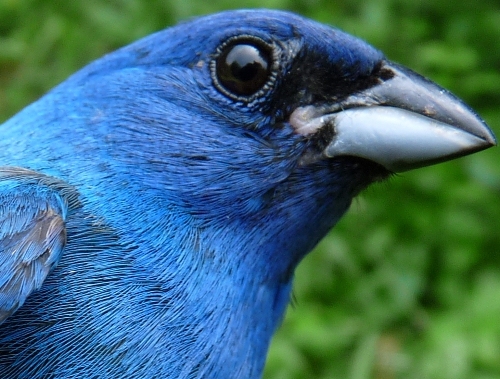
By August, most of the breeding birds at MBO have become rather quiet, or have even
already departed for staging grounds elsewhere, such as the blackbirds and swallows
do each July. But so far this August we've always been able to count on a couple of
male Indigo Buntings belting out their cheery song all morning long, every day. This
one,
banded last year around this time, paid us a return visit in the nets this week.
(Photo by Marcel Gahbauer)

|
MBO
gratefully acknowledges the financial support
provided for the 2009 Fall Migration Monitoring
Program by TD Friends of the Environment Foundation
|
|
|
|
THIS WEEK |
THIS FALL |
2009 TOTAL |
SITE TOTAL |
|
# birds (and species) banded |
148 (33) |
376 (47) |
1380 (73) |
20301 (105) |
|
# birds (and species) repeat |
35 (16) |
64 (19) |
343 (38) |
3690 (66) |
|
# birds (and species) return |
3 (3) |
9 (7) |
127 (29) |
581 (35) |
|
# species observed |
73 |
86 |
151 |
198 |
|
# net hours |
466 |
965.7 |
4324.2 |
34789.5 |
|
# birds banded / 100 net hours |
31.8 |
38.9 |
31.8 |
58.3 |
|
|
Note: table does not include nocturnal banding (owls) |
|
Banders-in-charge: Simon Duval, Marcel Gahbauer, Gay Gruner
Assistants: Christine Barrie, Anna De Aguayo, Jean Demers, Barbara Frei, Tiffany Gilchrist, Barbara MacDuff, Francine Marcoux, Clémence Soulard, Rodger Titman
Notes: This week was a lot quieter at MBO, as is sometimes the case for the second week of August. Nevertheless, we still had some great sightings. Species observed for the first time this fall include Canada Goose, Osprey, Red-tailed Hawk, Red-shouldered Hawk, Northern Goshawk (new for the year as well), Merlin, Chimney Swift, Traill’s Flycatcher, Olive-sided Flycatcher (new for the year as well), Common Raven, Brown Creeper, Marsh Wren (new for the year as well), Northern Waterthrush, Rusty Blackbird, and Purple Finch. Species banded for the first time this season include Hairy Woodpecker, Traill’s Flycatcher (including a distinct Willow Flycatcher), Red-breasted Nuthatch (new for the year as well), Brown Creeper, Yellow-rumped Warbler, Chestnut-sided Warbler, Northern Waterthrush, and Purple Finch.
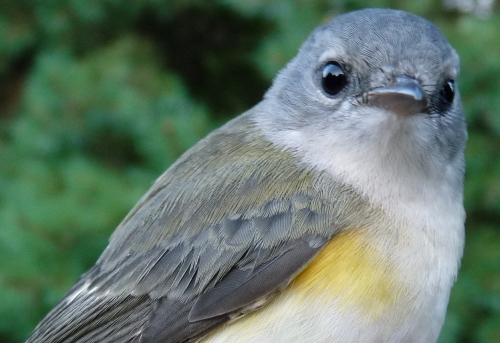
American Redstarts are one of our more common warblers each August, so we have started looking more closely at the variation in the colour of the patch on the side of the breast, classifying each one according to the "Naturalist's Color Guide". Above is a young male with "orange yellow" patches, while below is a female with "straw yellow" (Photos by Marcel Gahbauer)
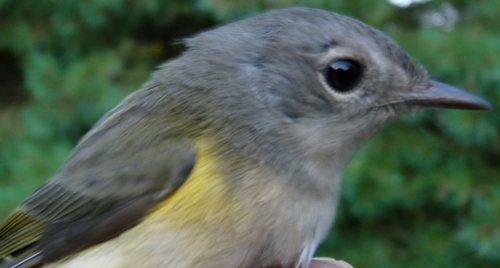
|
Among the list of species presented above, the Brown Creeper and Yellow-rumped Warbler really stand out, since typically we don't start seeing them until late August until the earliest, and their peak movement is in late September and early October. But as the photos below show, this week's birds were very young, so rather than being migrants from northern breeding grounds like most of the individuals we see of these two species, they must have come from a nest quite near MBO.

Surely it isn't Yellow-rumped Warbler season yet! Last fall, MBO experienced an unprecedented invasion of these birds from late September to mid-October, and we don't expect to see numbers like that again this fall. So, we were very surprised to catch this very young individual, the earliest in fall that we've ever banded one, by more than two weeks. (Photo by Marcel Gahbauer)
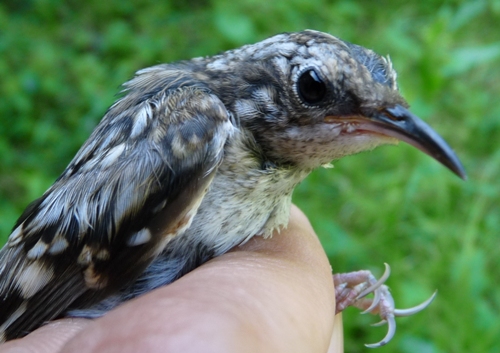
Another surprise this week in terms of timing was this Brown Creeper, also a record early date. Like the Yellow-rumped Warbler, it was still largely in juvenile plumage, suggesting that it hatched somewhere quite near MBO. (Photo by Marcel Gahbauer)
|
For the second week in a row, the species we banded most frequently were Song Sparrow and Yellow Warbler, bringing their respective totals for the season to 58 and 43 already. We tend to get Song Sparrows throughout the fall season, so that number will continue to grow substantially, but Yellow Warblers are a very early migrant and will likely become scarce within the next week or two. Even so, their total over the first two weeks already matches the highest previous fall total (recorded in both 2006 and 2007). Meanwhile, White-throated Sparrows are also off to an unusually strong start to the season, with 20 banded over the first two weeks, all but a couple of them juveniles. With the exception of Traill's Flycatcher and Chestnut-sided Warbler arriving in small numbers, the dominant species at the nets were mostly similar to week one, a reflection of the very stagnant air mass that has been hanging around Montreal since late in week one.
Similarly, eight of the ten most frequently observed species this week were also on the list last week, the only differences being the addition of American Crows and Canada Goose (beginning to fly over the site more regularly), and the removal of Yellow Warbler and Red-winged Blackbird (which have continued to move out of the area). Common Grackles remained at the top of the list for a second straight week, largely on the basis of fairly sizeable flocks on a couple of days. In contrast, the Black-capped Chickadees and American Goldfinches are mostly local residents at this point, with relatively similar numbers seen daily.
|
This week’s top 10
[last week's rank in brackets]
|
# individuals banded |
mean # individuals observed daily |
|
1. Song Sparrow (32)
[1] |
1. Common Grackle (18.1)
[1] |
|
2. Yellow Warbler (18)
[1] |
2. American Crow (17.0) [-] |
|
3. White-throated Sparrow (11)
[7] |
3. Black-capped Chickadee (15.9)
[2] |
|
3. Gray Catbird (11)
[9] |
4. American Goldfinch (13.4)
[6] |
|
5. American Redstart (10)
[4] |
5. Song Sparrow (12.7)
[5] |
|
6. Traill's Flycatcher (7) [-] |
6. Cedar Waxwing (11.0) [4] |
|
7. Common Yellowthroat (5)
[-] |
7. Canada Goose (8.9)
[-] |
|
7. Rose-breasted Grosbeak (5) [3] |
8. American Robin (8.6) [3] |
|
9. House Wren (4) [5] |
9. Gray Catbird (8.4) [10] |
|
9. Red-eyed Vireo (4) [9]
9. Chestnut-sided Warbler (4)
[-]
|
9. House Wren (8.4)
[7] |
|
We've endured a very hot and humid week and on the whole are pleasantly surprised with the variety of species we observed and banded despite the distinctly non-fall-like weather. All the same, we're looking forward to at least slightly cooler weather in week three, and perhaps a nice wave of warblers to come along with it and shake up our on-site numbers a bit more for the next report...
|
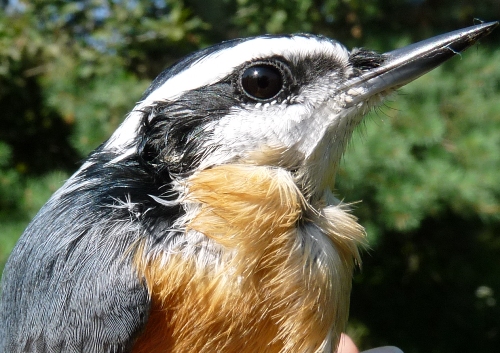
Although Red-breasted Nuthatches are reasonably common in the region, we don't tend to see them at MBO with any regularity, and band them even more seldom. In fact, this male was only the fourth one we've banded, and the first since 2006!
(Photo by
Marcel Gahbauer)
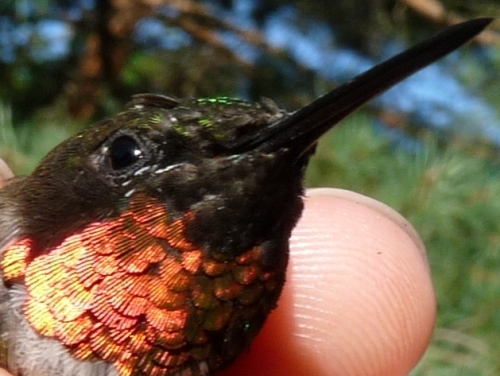
Although we aren't banding hummingbirds, that doesn't stop them from flying into our nets at times. At this time of year most of the Ruby-throated Hummingbirds we see are actually white-throated, so this gorgeous after-hatch-year male was a wonderful surprise..
(Photo by Marcel Gahbauer)
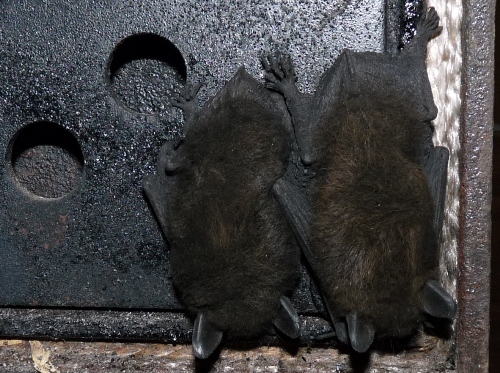
Early in the week, we heard some scratching from inside the stove pipe ... and opened the door to find these two little brown bats hanging on the inside of it! We saw them three mornings in a row, then they seemed to move on to find a quieter bedroom.
(Photo by Marcel Gahbauer)
|









